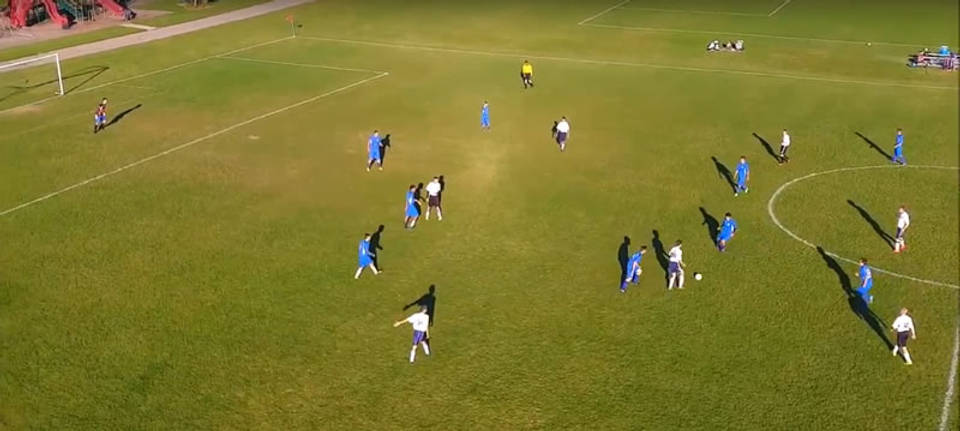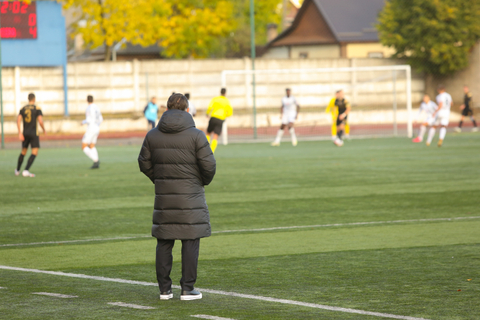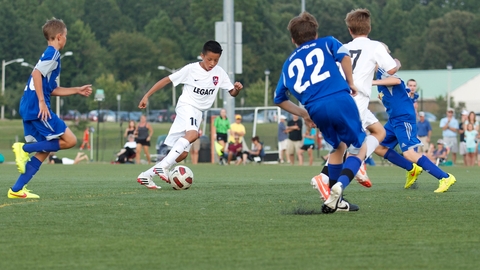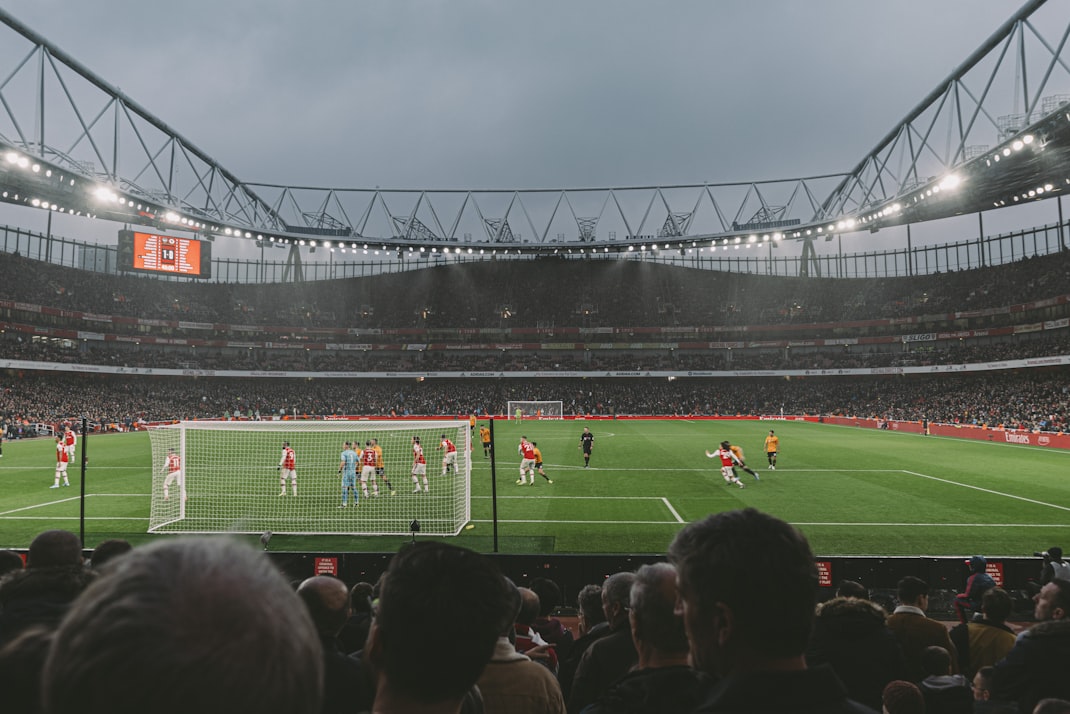Football formations shape the way teams play and control the flow of a match and have evolved from simple arrangements to complex systems that adapt during matches.
Modern teams switch between formations to exploit weaknesses in their opponents or respond to changes in the game.
The flexibility of these systems lets managers adjust their team's approach without making substitutions.
Picking the right formation depends on your players' skills and how you want to play.
A formation that works brilliantly for one team might fail for another, which makes understanding your squad's capabilities essential for tactical success.
Key Takeaways
- Different formations suit different playing styles and player strengths
- Modern football requires teams to master multiple formations for tactical flexibility
- Team success depends on matching formations to available talent and tactical goals

4-4-2
The 4-4-2 formation stands as one of football's most traditional and effective setups, featuring four defenders, four midfielders, and two strikers working in tandem.
Strengths
The 4-4-2 provides excellent defensive stability through its two banks of four players. These lines make it difficult for opponents to play through the middle.
The formation enables strong counterattacking play, with two strikers ready to break forward quickly when possession is won.
Wide midfielders offer natural width and crossing opportunities, whilst also helping defend against opposition wingers.
The partnership between the two forwards creates multiple attacking options. One striker can drop deep whilst the other pushes the defensive line.
Weaknesses
Teams can become outnumbered in midfield when facing formations with three central midfielders, like 4-3-3 or 4-2-3-1.
The system requires extremely fit wide midfielders who can both attack and defend effectively throughout the match.
If the strikers don't work well together, the team can become disconnected between midfield and attack.
Used By
Premier League Era:
- Manchester United under Sir Alex Ferguson
- Leicester City during their 2015-16 title-winning season
- Burnley under Sean Dyche
Current Teams:
- Atletico Madrid frequently adopt this shape
- Many English Championship sides
- Several Italian Serie A clubs maintain this traditional setup
The formation remains particularly popular in English football, where its direct and structured approach suits the fast-paced nature of the game.
4-3-3
The 4-3-3 formation uses four defenders, three midfielders, and three forwards to create a balanced attacking system. This setup allows teams to control possession while maintaining strong attacking options through the wide areas.
Strengths
Three forwards spread across the front line create width and stretch opposing defences. The formation gives wingers freedom to cut inside or stay wide, making them harder to mark.
The midfield trio provides flexibility in both attack and defence. One defensive midfielder can shield the back four while two advanced midfielders support the attack.
Teams can press high up the pitch effectively with the three forwards leading the defensive effort.
The system works well for teams that like to dominate possession, as the triangular passing options help maintain control of the ball.
Weaknesses
The formation requires highly skilled wingers who can both attack and track back to help defend. Without proper defensive work from the forwards, teams become vulnerable on the flanks.
The midfield three can become overwhelmed against teams playing with four central midfielders.
Full-backs must be extremely fit to provide width when wingers move inside. This can leave spaces behind them for counter-attacks.
Used By
Liverpool under Jürgen Klopp use this system to great effect, with their forwards switching positions fluidly during matches.
Barcelona mastered this formation during Pep Guardiola's reign, using it to dominate European football from 2008-2012.
Ajax Amsterdam traditionally favour the 4-3-3, using it to develop talented young players in clearly defined roles.
Manchester City often employ this shape, especially when facing teams that sit deep against them.
4-2-3-1
The 4-2-3-1 formation creates a solid defensive structure while enabling fluid attacking movement through its five midfielders. This modern system relies on defensive stability from two holding midfielders and creative freedom for three attacking midfielders supporting a lone striker.
Strengths
Two defensive midfielders protect the back four and control the centre of the pitch. This creates a strong defensive base that's difficult to break down.
The three attacking midfielders can interchange positions freely, making it hard for opponents to mark them effectively. They can also drop back to form a five-man midfield when needed.
The formation allows teams to press high up the pitch with the front four players while maintaining defensive security.
Wide attackers can cut inside to support the striker or stay wide to stretch the defence, giving multiple attacking options.
Weaknesses
The lone striker can become isolated if the attacking midfielders don't provide enough support quickly.
Teams need technically skilled midfielders who can transition between attack and defence rapidly. Without these players, the formation loses its effectiveness.
The system requires excellent communication between the defensive midfield pair to avoid leaving gaps.
Wide areas can be exposed if the attacking midfielders don't track back to help defend.
Used By
Manchester City have used this formation effectively under Pep Guardiola, with their fluid movement and positional rotation.
Real Madrid employed this system during their Champions League victories, using skilled midfielders to control matches.
Bayern Munich regularly deploy the 4-2-3-1, making use of quick wingers and a strong striker.
The German national team won the 2014 World Cup using this formation, demonstrating its effectiveness at the highest level.
3-5-2
The 3-5-2 formation creates a solid defensive foundation while maintaining strong attacking options through wingbacks and two strikers. The setup features three centre-backs, five midfielders including two wingbacks, and a striker partnership up front.
Strengths
Three centre-backs provide excellent defensive coverage across the width of the pitch. The formation allows both wingbacks to push forward and create overlapping runs without leaving gaps at the back.
The two strikers work together to pressure opposing defences and create scoring chances. This partnership often forces defenders to make difficult decisions about marking assignments.
The midfield trio can control possession and dictate the tempo of matches. With five players across the middle, teams can easily switch between defensive and attacking phases.
Weaknesses
Wide areas can become exposed if wingbacks push too far forward. Teams need excellent communication between the three defenders to avoid being caught out.
The formation demands exceptional fitness levels from wingbacks who must cover the entire length of the pitch. Players in these positions need both attacking and defensive skills.
The system struggles against teams that play with quick, wide forwards who can exploit spaces behind advancing wingbacks.
Used By
Club Teams:
- Inter Milan (during their 2020-21 title-winning season)
- Sheffield United (during Premier League promotion campaign)
- Conte's Chelsea (2016-17 Premier League champions)
National Teams:
- Germany (various periods)
- Netherlands (2014 World Cup)
The formation works best with physically strong centre-backs and energetic wingbacks who can maintain high stamina throughout matches. Teams need technically skilled midfielders who can transition between defence and attack.
3-4-3
The 3-4-3 formation uses three central defenders, four midfielders, and three forwards to create an aggressive attacking setup. This formation gained popularity in recent years for its flexibility and ability to control possession.
Strengths
The formation creates natural width through advanced wing-backs who can both attack and defend. Three forwards put immense pressure on opposing defences and create multiple scoring opportunities.
The midfield quartet allows teams to dominate possession in the centre of the pitch. Two central midfielders provide stability while wing-backs offer support in attack.
The three-man defence gives solid protection against counter-attacks when organised properly. Centre-backs can spread wide to cover spaces left by advancing wing-backs.
Weaknesses
Wide areas become vulnerable when wing-backs push forward, leaving large gaps behind them. This requires excellent positioning and stamina from the entire team.
Quick opponent transitions can exploit spaces between defenders. The three-man backline must maintain perfect coordination to avoid being caught out.
Teams need technically skilled players in every position. Wing-backs especially must excel at both attacking and defending, which makes finding suitable players challenging.
Used By
Antonio Conte pioneered modern use of 3-4-3 with Chelsea during their 2016-17 Premier League title win.
Current Notable Teams Using 3-4-3:
- Chelsea FC (periodically)
- Inter Milan
- Atalanta
- RB Leipzig
The formation works best with teams that have:
- Athletic wing-backs
- Ball-playing centre-backs
- Mobile forwards who can rotate positions
4-1-2-1-2
The 4-1-2-1-2 formation creates a narrow, diamond-shaped midfield that excels at quick passing combinations through the centre. This setup uses two strikers up front with strong midfield support.
Strengths
The diamond midfield allows for excellent ball control and passing options in central areas.
Two strikers working together create multiple attacking threats and crossing opportunities.
The defensive midfielder shields the back four while providing a link to the attacking players.
This creates a strong spine through the middle of the pitch.
Quick one-touch passing between the midfielders can break down stubborn defences.
The formation naturally creates passing triangles that help maintain possession.
The attacking midfielder has freedom to find space between the opposition's defence and midfield lines.
This player becomes crucial for creating chances for the strike partnership.
Weaknesses
The narrow shape leaves the wings exposed, making the team vulnerable to attacks down the flanks.
Full-backs must work extremely hard to provide width in attack and defence.
Teams using this formation can struggle against opponents who pack the middle of the pitch.
The lack of natural width means crossing opportunities are limited.
Counter-attacks become risky since the full-backs often push forward to provide width.
This can leave large gaps in defence if possession is lost.
Used By
AC Milan used this formation during their dominant period in the early 2000s under Carlo Ancelotti. Andrea Pirlo excelled as the deep-lying playmaker.
Liverpool employed this setup under Rafa Benitez with Steven Gerrard supporting Fernando Torres and Dirk Kuyt up front.
Real Madrid have used variations of this formation, particularly when partnering Karim Benzema with another striker.
The formation remains popular in Italian football, where teams traditionally focus on strong central play rather than wing attacks.
4-5-1
The 4-5-1 formation puts control in the middle of the pitch with five midfielders supporting a single striker.
Many top teams use this defensive setup as a base formation that can quickly shift into more attacking variations.
Strengths
The five-player midfield creates a solid defensive block that makes it difficult for opponents to play through the centre.
Teams can press effectively and win back possession quickly.
The wide midfielders can drop back to help defend or push forward to support attacks.
This flexibility allows smooth transitions between defence and attack.
The formation excels at controlling possession through the midfield.
The extra players in the middle can pass and move to tire out opposing teams.
Weaknesses
The lone striker can become isolated without proper support from midfield runners. This can make it hard to create scoring chances.
Teams may struggle to break down packed defences if the midfielders don't get forward quickly enough to help the striker.
The formation can appear overly defensive if players don't take risks going forward.
The team needs dynamic midfielders who can cover ground.
Used By
Jose Mourinho regularly employed the 4-5-1 during his spells at Chelsea and Inter Milan. His teams were known for solid defensive organisation.
Borussia Dortmund have used variations of the 4-5-1, especially in big matches where midfield control is crucial.
The formation suits teams with strong box-to-box midfielders who can both defend and attack. Crystal Palace and Newcastle United have found success with this setup in recent seasons.
4-2-3-1
The 4-2-3-1 formation uses four defenders, two defensive midfielders, three attacking midfielders, and one striker. This modern setup offers excellent balance between attack and defence.
Strengths
Two defensive midfielders create a solid shield in front of the back four. This protection lets full-backs push forward to support attacks.
The three attacking midfielders can press high up the pitch and create multiple passing options.
They can quickly switch positions to confuse defenders.
The lone striker receives support from multiple angles, with attacking midfielders making runs from deep positions.
This formation excels at possession-based football, with the two holding midfielders recycling the ball effectively.
Weaknesses
The single striker can become isolated if the attacking midfielders don't push forward quickly enough.
Teams need technically skilled players in all midfield positions for this formation to work properly.
Wide players must be fit enough to help in both attack and defence, which can be physically demanding.
The formation can struggle against teams that play with two strikers, as the centre-backs face a numerical disadvantage.
Used By
Manchester City have mastered this formation under Pep Guardiola, using it to dominate possession and create chances.
Bayern Munich regularly employ 4-2-3-1, using quick transitions between defence and attack.
Real Madrid often use this setup, particularly with strong holding midfielders protecting the defence.
Arsenal have found success with 4-2-3-1, using technical midfielders to control matches.
Several national teams, including Germany and France, frequently use this formation in major tournaments.
4-4-1-1
The 4-4-1-1 formation creates a balanced tactical setup with four defenders, four midfielders, one attacking midfielder, and a lone striker. This system offers defensive stability while maintaining attacking options through the second striker position.
Strengths
The formation protects against counter-attacks with its solid defensive base of four defenders and four midfielders.
The attacking midfielder can drop deep to help control possession or push forward to support the striker, making the system very adaptable.
Wide midfielders provide natural width and crossing opportunities while offering defensive cover when needed.
The second striker's free role creates confusion for opposing defenders, as they struggle to track the player's movement between the lines.
Weaknesses
The lone striker can become isolated if the attacking midfielder fails to provide quick support.
The formation can struggle against teams that dominate central areas with three midfielders.
Wide areas can be exposed if the wingers push too far forward, leaving full-backs vulnerable.
Teams need technically skilled players in the attacking midfielder role to make this system work effectively.
Used By
Manchester United employed this formation during Wayne Rooney's prime years, with him excelling in the second striker role.
Atlético Madrid have used this setup under Diego Simeone, often with João Félix playing behind the main striker.
Many European clubs adopt this formation when facing stronger opponents, as it offers good defensive structure while maintaining counter-attacking threat.
The system remains popular in the Premier League, where teams value both defensive solidarity and attacking flexibility.
5-3-2
The 5-3-2 formation creates a solid defensive wall while maintaining attacking potential through wing-backs. This setup uses three central defenders with two wing-backs who transition between defence and attack.
Strengths
The defensive line of five players makes it tough for opponents to break through. Three centre-backs provide excellent coverage in the box.
Wing-backs have freedom to push forward and create width in attack. They can deliver crosses while the two strikers make runs into dangerous areas.
The three midfielders control the centre of the pitch effectively. One often plays deeper as an anchor, letting the other two support attacks.
Weaknesses
Wing-backs must be incredibly fit to handle their dual attacking and defensive duties. If they tire, huge gaps appear on the flanks.
The formation can become too defensive if wing-backs don't push forward enough. This leaves strikers isolated up front.
Teams can struggle to maintain possession with only three midfielders. Opposition sides with four midfielders often dominate the middle.
Used By
Chelsea used this formation under Antonio Conte to win the 2016-17 Premier League title. Their wing-backs, Marcos Alonso and Victor Moses, were crucial to their success.
Inter Milan employed the 5-3-2 effectively under both Conte and Simone Inzaghi. The system suited their strong centre-backs and attacking wing-backs perfectly.
Sheffield United found success with overlapping centre-backs in this formation during their 2019-20 Premier League campaign.
How to Decide Which Formation to Use
The first step in picking a formation is to assess your team's strengths.
Look at the skills and physical attributes of your players to match them with positions where they can excel.
Consider your available players' stamina levels and work rates.
Some formations like 3-4-3 need very fit midfielders who can support both attack and defence throughout the match.
Key factors to evaluate:
- Player technical abilities
- Physical fitness levels
- Team experience
- Opposition tactics
- Match conditions
The balance between attack and defence is crucial.
A team with strong forwards might benefit from an attacking 4-3-3, while those with solid defenders could use 4-4-2 for stability.
Study your opponents' playing style.
If they use wide attacking players, you might need full-backs or wing-backs for defensive cover.
Match situations matter:
- Home vs away games
- League or cup matches
- Weather conditions
- Pitch size and quality
Try formations in training sessions first.
This gives players time to learn their roles and develop an understanding with teammates.
Be ready to adapt during matches.
Smart managers prepare a backup formation to switch to if the original plan isn't working.
The most effective formation should feel natural to your team.
Don't force a trendy system if it doesn't suit your players' capabilities.
Changing Formation Mid-Game
Switching formations during a match can provide a tactical advantage and help teams adapt to changing game situations.
Successful managers prepare their teams to handle multiple formations before matches begin.
Players need proper training to understand different roles and positions.
This helps them adjust smoothly when tactical changes occur during play.
There are several common reasons to change formation:
- Coming back from a deficit
- Protecting a lead
- Countering the opponent's tactics
- Dealing with player injuries or red cards
- Exploiting weaknesses in the opposing team
The best time to switch formations is during natural breaks in play:
- Half-time
- During substitutions
- At goal kicks
- During injury stoppages
A famous example comes from the 2003 UEFA Champions League final.
AC Milan switched from 4-3-1-2 to 4-3-2-1 in the second half to gain more control of the midfield.
Teams should practise transitioning between 2-3 main formations in training.
This creates muscle memory and reduces confusion when changes happen in matches.
Quick communication is essential when changing shape.
The captain and senior players must help organise the team and ensure everyone understands their new roles.
Classic Examples of When Formations Worked
Liverpool under Jürgen Klopp perfected the 4-3-3 formation during their 2019-20 Premier League title win. Their system relied on attacking full-backs and a dynamic front three that scored 85 goals that season.
Pep Guardiola's Barcelona team from 2008-2012 showed the power of the 4-3-3. With Messi as a false nine and technical midfielders like Xavi and Iniesta, they won 14 major trophies using this setup.
The Brazil national team's 4-2-4 formation in the 1958 World Cup brought them their first title. This attacking style let stars like Pelé and Garrincha thrive in wide areas.
Key Formation Success Stories:
- Uruguay (1950): 4-3-3 formation to win World Cup
- AC Milan (1980s): 4-4-2 under Arrigo Sacchi
- Ajax (1995): 3-4-3 to win Champions League
Jose Mourinho's Chelsea used the 4-3-3 to win back-to-back Premier League titles in 2004-06. Their solid defensive base and quick counter-attacks made this formation deadly.
The German national team's 4-2-3-1 proved perfect for their 2014 World Cup victory. This setup gave them the right mix of defence and attack while allowing creative players freedom to express themselves.
Frequently Asked Questions
Football formations shape team strategies and determine player positions on the pitch. The right setup maximises strengths while accounting for skill levels across different age groups and playing styles.
What are the top-rated formations employed in professional 11-a-side football leagues?
The 4-3-3 formation remains popular in top leagues due to its attacking potential and midfield control. Many Premier League teams use this setup.
The 4-2-3-1 offers defensive stability while maintaining attacking options through a single striker and three attacking midfielders.
The classic 4-4-2 continues to prove effective, especially for teams with strong striking partnerships.
How do tactics and formations in 11-a-side football differ for youth teams, such as under-13s?
Youth teams often benefit from simpler formations that emphasise basic positioning and movement. The 4-4-2 works well as it pairs players together, making it easier to learn.
Coaches should focus on rotational play and equal time in different positions to develop varied skills.
What are the strategic benefits of using a 4-3-3 formation in 11v11 football?
The 4-3-3 creates width in attack through advanced wingers. This stretches opposing defences and creates space for midfield runners.
Three forwards put immediate pressure on opposing defenders when losing possession.
The formation allows for quick transitions between attack and defence through its triangular passing options.
In 11-a-side football, where should less skilled players be positioned to strengthen the team's performance?
Less experienced players often perform well in full-back positions, where they have the touchline as a guide and fewer decision-making demands.
Central midfield might prove challenging for newer players due to its 360-degree nature of play.
Can you recommend any resources for printable diagrams of 11v11 soccer formations?
FA Learning offers free downloadable formation templates and tactical boards for coaches.
Many football coaching websites provide printable pitch diagrams with moveable player markers.
What are the common variations of the 4-4-2 formation in competitive 11-a-side football?
The 4-4-2 diamond uses a narrow midfield with an attacking midfielder at the tip and defensive midfielder at the base.
The 4-4-2 flat relies on traditional wingers and solid central midfield partnerships.
Some teams employ a 4-4-2 with one striker dropping deeper, creating a 4-4-1-1 variation.

















